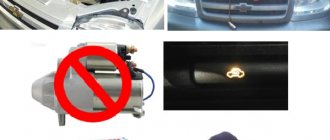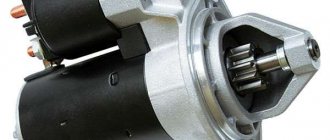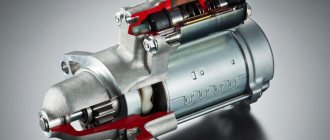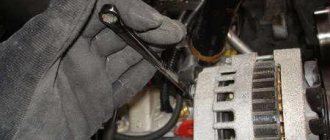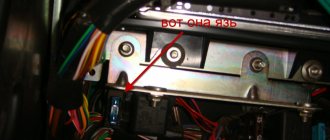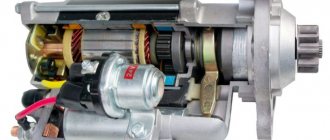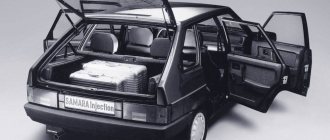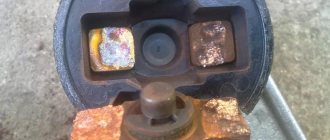To find out why the starter clicks but does not turn, it is necessary to disassemble its structure and switching circuit, including the components on which its operation depends. Let's divide the entire structure that interests us into three elements: the power system - for the starter, this is, first of all, the battery; switching – all connections (wires and relays); the starter itself.
OPTION ONE – Battery
This is perhaps one of the most common types of malfunctions of this kind. Its essence lies simply in a discharged or inoperative battery. It is easy to determine if the battery is discharged: if the solenoid relay clicks, but the starter does not turn, and the lights on the dashboard go out, the culprit is the battery; when a series of clicks occurs, and the lamps also noticeably dim, then, as in the previous case, the battery is to blame; if nothing happens at all, then the battery may also be discharged - you need to check it with other loads (for example, turn on the headlights). If the cause is the battery, then it would seem that everything is simple - just charge it (or light it) and you can hit the road. But not everything is so simple, because the unclear reason that caused the consequence in the form of an unsuccessful launch will cause the same consequence again. Therefore, it is worth figuring out why the battery was discharged.
Battery discharge. Why?
Everything is elementary if a light was simply left on somewhere, or another consumer was left on. But if everything was turned off, then it is necessary to check the quality of the generator, as well as the serviceability of the battery itself.
SWITCHING
Switching the starter is simple - the plus of the battery is screwed to the solenoid relay, the minus is on the housing, and for starting, a small cross-section wire from a typical relay, which is controlled by the ignition switch, is suitable.
RELAY
If, when you turn on the ignition, the relay clicks, but the starter does not turn (and the solenoid relay also does not work), then the reason may be in the relay itself or the control cable. You can accurately install it in a fairly simple way - you need to apply “+” power to the starter control terminal (where the cable of the smallest cross-section is connected, shown with an arrow in the photo). how to check the relay and wiring If the starter starts to “turn”, then the reason is in the wiring, relay or ignition switch. Note. Before checking, you must make sure that the car's gearbox is in neutral, otherwise the car may start moving. By the way, if the trip is urgent, then you can start the engine this way. You just need to turn on the ignition and manually (by applying positive power to the control terminal) start the engine.
BAD CONTACTS
If the starter clicks but does not turn and, at the same time, extraneous sounds occur (as an option, it sometimes clicks, sometimes it does not click) - you need to check all connections, especially the power cable. The point here is that when starting the engine, the starter consumes quite a lot from the battery - about 200 amperes. If the contact is insufficient somewhere, then out of the required 200 it can “get” only 10, which is enough for the solenoid relay to operate, but not enough to start. In the same case, a series of “clicks” may occur. It is necessary to check all connections (including battery terminals), clean the contact pads from oxides, lubricate them with special lubricant and tighten to the recommended torque.
Where is the starter relay located?
Many drivers have encountered such an unpleasant situation when the starter does not want to turn the engine and start the car.
And it’s not a matter of the battery, because even no attempts are made to move the power unit. There is just a kind of click and nothing else happens. In such a situation, you have to push start the car or come up with other ways to start the engine. If the starter clicks but does not turn, there are several types of car problems that are worth paying attention to. This problem will have to be solved immediately after it occurs, because further movement is only possible with a working starter. Especially when it comes to large cars, which cannot be started from a pusher.
Every car owner will be familiar with this situation when the morning starts late and you start rushing to work or on errands. But it happens that after an overnight stay, the car simply refuses to start, or starts after numerous attempts.
And such problems are not the norm and require careful diagnosis and testing. Since there may be plenty of reasons for malfunctions, you should carefully read the main ones and check them in practice.
The starter is also tested under full braking. Often there may be a manufacturing defect.
If, when you turn the ignition key, clicks are heard from the starter relay, but the unit itself does not spin, then the problem may be associated with a malfunction of the control cable that powers the relay, or with a problem in the performance of the relay itself.
In such a situation, the car can be started if you short-circuit the “plus” from the battery to the positive control terminal from the ignition switch (the smallest wire of the three is connected to it). If, with such a connection, the starter starts to spin, then the malfunction is definitely not related to the battery, and the problem should be looked for in the relay, ignition switch or wiring.
In practice, most of the problems and malfunctions when the starter operates are problems with the electrical part. Mechanical failures are less common. Problems with starting the vehicle's power unit, which are caused by electrical faults.
If you cannot start the car, you need to check its battery for functionality, since the starter is powered from it. If the power supply is insufficiently charged, the characteristic sounds of the engine starting system may be completely absent. You can measure the battery charge using a voltmeter.
If it is less than 9V, it is necessary to recharge the battery, otherwise further loss of capacity may negatively affect its operation. If there is no tester, you can determine how charged the battery is by the brightness of the headlights, although this requires some experience. If, when the high beam is on and the ignition key is turned in the lock, the headlights begin to shine weaker, it means that the battery charge has decreased significantly.
If the starter clicks but cannot turn the engine, you need to test the solenoid relay. In addition to the failure of this part, problems may arise with the power cable. To determine the functionality of the relay, it is recommended to connect it directly to the battery terminals. If the traction works with such a connection, the cause of the problem must be sought in the power system (damage to the wires, burnt relay contacts, a malfunction in the ignition switch). After troubleshooting, the engine starting system will function properly.
Insufficient contact or its absence leads to a loss of current in the vehicle's electrical network, which is why its consumers function incorrectly. Therefore, it is necessary to periodically pay attention to all connections in the on-board network. For normal functioning of the starter, a current of approximately 200A is required. At a lower starting current, only the pull-in winding of the relay is activated. However, the power unit cannot start.
When the VR is not working well, when you try to start the engine, clear dry clicks are heard; if the cause of the defect is a contact relay, the clicking in this case is quiet and quite soft. First, we check the functionality of the starter itself, this is done something like this:
- remove the starting device from the car;
- We connect the terminal wires to the removed battery, connecting their other ends to the main positive and ground of the starter;
- we connect another wire to the starter winding, with its other end we touch the positive terminal of the battery, while holding the starting device;
- if the starter is working, the bendix will engage, the rotor will rotate, if not, there will be no rotation, and when voltage is applied, slight sparking will occur;
- To completely make sure that the starter does not respond or, on the contrary, responds to the power supply, we apply plus directly to the winding.
Now, without disassembling the starter assembly, you can check the operation of the solenoid relay:
- apply minus to the winding output;
- briefly touch the BP contact pin, where power is supplied from the ignition switch (on many cars this contact is equipped with a “chip”);
- when power is applied and the relay is working properly, a clear click will be heard, and the bendix will move backward;
- if the bendix does not come out, you need to disassemble and diagnose the solenoid relay.
You can also check the VR when it is removed from the starter; here we also supply power with wires from the battery (plus and minus). When “ ” is applied to the control contact, the core on a working relay will be retracted; if the VR is faulty, the full stroke of the core is not observed.
The starter contact relay (SCR), which is usually located inside the car or in the engine compartment on the panel next to the windshield wipers, may also be faulty. In this case, when you turn the ignition key, faint clicks may be heard, or more often no sounds can be heard at all. Before you start checking the RPC itself, you need to make sure that power is supplied to the relay.
It should be taken into account that each car model has its own circuit, some cars have a starter blocking relay installed (has a different purpose), some cars do not have a starter lock relay at all. You need to check the chain according to the electrical diagram, but the principle of operation, we assume, is generally clear.
And also interesting: Generator Niva 2121, 21213, 21214: which one is installed, replacement || Chevy Niva generator voltage
The ECR itself is also checked using a test light or a multimeter, but when searching for a defect on your own, it is more convenient to have a working relay in stock, given that the part is inexpensive and is almost always available in car dealerships.
You can check the starter traction relay with your own hands using an autotester. To do this, you first need to measure the voltage from the battery at the starter contact. After this, the tester probe is connected to the starter output, after which it is necessary to turn on the ignition and turn the key to the “start” position.
During measurements, you need to pay attention to the following: if measurements at the input show a voltage that corresponds to the normal charge of the battery, but when the traction relay is activated, the voltage at the output drops 2-3 times, then there is a high probability of burning out the power contacts of the traction relay.
If the traction drive malfunctions, the starter clicks and does not turn the engine. The fact is that burnt contacts cannot transmit voltage completely due to insufficient contact.
If the input voltage corresponds to the voltage of a charged battery and a similar voltage indicator is noted at the output of the traction relay, then the contacts of the traction relay are in perfect order. This indicates that the breakdown occurred in the starter. In the first case, the traction relay should be disassembled, after which the contacts should be cleaned, and the jumper plate should also be cleaned.
Nothing irritates a driver more than the silence of the starter in response to turning the key in the ignition. There are many reasons why a car won't start.
Starting from the banal disconnection of contacts, ending with the failure of the starter. External manifestations of a breakdown can also be different, and if you know the design of the starting system, you can quickly find a weak point.
If, when trying to start, the starter clicks and nothing else happens, this significantly narrows the troubleshooting sector.
Clicks under the hood when trying to start the engine are generated by the retractor relay, which is responsible for the engagement of the Bendix working gear with the flywheel ring. Not very experienced drivers believe that such clicks can be produced by the starter relay, and they consider the solenoid relay to be the culprit of the breakdown.
If the starter clicks but does not turn, then this is not at all a reason to blame the “retractor” (as the retractor relay is briefly called), because current flows to it, otherwise there would be no sounds at all. And the starter relay makes clicks during its operation, but they are almost inaudible, so this sound cannot be confused with anything.
The starter relay is located under the auxiliary fuse box next to the ignition relay. On the VAZ 21214, the starter activation relay is attached to the injection system relay bracket.
Modification: heat protection casing
As a rule, the starting device on the Niva and other domestic cars begins to deteriorate like this. At first it is difficult to start the engine, then a whistle appears. When parked for a long time, the car does not start at all, and the battery quickly runs out. If the device is not diagnosed in such a situation, the problem will get worse. There are usually two reasons why the starter is not checked immediately:
- battery - if replaced, the battery will withstand a faulty starter for some time, and the engine will start properly;
- wires and terminals are cleaned of rust, which improves the current supply and plant, but also for a short time.
Reasons why Lada 4×4 does not start (the starter does not turn)
| Possible malfunction | Diagnostics | Solution |
| Battery is discharged | The starter clicks but does not turn. The voltage at the battery terminals with consumers turned on is less than 12 V | Charge or replace the battery |
| Oxidation of battery terminals or poor connection | The starter clicks but does not turn. When the starter is turned on, the voltage at its terminals drops much more than at the battery terminals | Clean the contacts, lubricate with Vaseline and tighten well |
| There are problems in the wiring of the starter traction (retractor) relay, ignition contacts 30 and 50 do not close. | When turning the key there is no click under the hood (the relay does not work). Check the presence of voltage at the control contact of the solenoid relay | Clean the contacts, lubricate with Vaseline and tighten well. Replace the ignition switch |
| The starter solenoid relay is faulty. | When you turn the key, there is no click under the hood (the relay does not work), but there is 12 V at the control contact of the solenoid relay. The starter spins when closed with a screwdriver. The starter does not turn only when it is hot (when the engine is warm) | Replace starter relay |
| Solenoid relay contacts are oxidized, poor ground contact | When you turn the key there is a click under the hood, but the starter does not turn. Using an ohmmeter, check the resistance of the “battery - starter” circuit, as well as the ground wire. If the circuits are OK, remove the starter and check the operation of its relay | Clean the contacts, lubricate with Vaseline and tighten well. Replace the solenoid relay |
| Open or short circuit in the holding coil of the solenoid relay | When the starter is turned on, a cracking noise is heard from under the hood. The battery voltage is within normal limits. The relay is checked with an ohmmeter or by its excessive heating | Replace starter relay |
| Burnt starter commutator, stuck brushes or severe wear | The starter does not turn or turns slowly. With the starter removed, check the pressing force of the brushes to the commutator, their residual height, and wear of the commutator | Repair the starter. If the commutator is very worn, replace the starter. |
| Open or short circuit in the starter armature winding | The starter does not turn or turns slowly. The serviceability of the winding is checked with an ohmmeter or by darkening of the insulation | Replace starter |
| Freewheel slipping | The starter spins, but the flywheel is stationary | Replace clutch or starter |
| The ring gear rotates on the flywheel | The starter spins, but the flywheel and crankshaft are stationary. There is a squeal, a howl from the clutch housing | Replace flywheel |
| The engine or attachments are jammed | Check the rotation of the crankshaft, alternator pulleys, coolant pump and power steering pump | Repair the engine or its attachments |
| The starter drive gear or flywheel ring teeth are damaged | Visual inspection after removing the starter | Repair or replace starter, replace flywheel |
Have you encountered the problem of starting the engine when the starter does not turn? What was the cause of your problem? Let us remind you that other instructions for repair and operation of Lada 4×4 can be found in this category or by content.
Keywords: 4x4 starter | 4x4 engine | 4x4 ignition system | 4x4 power system | ECM 4x4
Found an error? Select it and press Ctrl Enter..
- The dollar has risen in price, AvtoVAZ may increase prices for LADA
- What kind of oil to pour into the gearbox of LADA cars
- Noise, crackling, knocking creaking when turning the steering wheel of a Lada car
- Review and installation of aerodynamic wheel guards on Lada cars
Often, owners of a VAZ 2121 or 2131 SUV encounter problems with starting the engine. For example, when you turn the ignition key, the starter does not turn. Let's look at possible problems with the Niva 4x4 starter and ways to solve them.
The condition of the roads and external conditions in our country are such that many people need a cross-country vehicle. The Chevrolet Niva is considered an excellent option that combines a low price and good quality. When operating this machine, special attention must be paid to the starter, the rules for its use and repair.
Also interesting: DIY Niva 21213 transfer case repair: video instructions
January 28, 2016 LadaOnline 150 630
Often, owners of a VAZ 2121 or 2131 SUV encounter problems with starting the engine. For example, when you turn the ignition key, the starter does not turn. Let's look at possible problems with the Lada 4×4 starter and ways to solve them.
If the car does not react in any way to turning the key, you need to check the devices sequentially in the following order.
Spark plug
It is not difficult to diagnose spark plugs; you just need to unscrew them from the landing wells and visually inspect them.
They should not be damp, soot must be within the normal range. It is best to compare their condition with our comparison table, which clearly indicates what the spark plugs say about a particular malfunction. Please note that it is better to replace all four spark plugs at once, leaving only the serviceable old ones for replacement.
This is what the comparison table for spark plug soot looks like.
Chevrolet Niva starter does not turn - Auto repair
When you turn on the ignition it does not start with the key, you just turn it on directly. Tell me, what could be the reason? Thank you in advance.
- When heated to 90 or more, the starter is silent in Niva Chevrolet - 2 answers
- The retractor clicks, but the starter does not turn, Niva Chevrolet - 3 answers
- Chevy Niva will not start from the starter - 3 answers
- The engine will not start until the Niva Chevrolet cools down - 2 answers
- The cigarette lighter on the VAZ 2123 does not work - 2 answers
If the car is from 2009, then check relay No. 5 in the passenger compartment, also check the contact group of the ignition switch, the cleanliness of the contacts on the starter.
The alarm there does not have a blocking relay. This is what we still need to understand. Have you looked at the plus on the starter solenoid relay? Thin wire on the starter.
There is a lot of correspondence, but what engine is not written about. There is also no information about what year the car was made. Before the restyling there were some fuse block diagrams, after - others.
The instrument panel time and daily mileage are reset when the power is turned off. So look in this direction - why the tension disappears. Start by checking the fuses, maybe the contact disappears from time to time (not reliable contact).
So, let’s look at the main reasons why the engine may not start when “cold” below.
Gasoline pump
In order to find out whether the fuel pump is working, there is no need to go anywhere. You just need to listen a little while turning the key in the ignition. Because when the fuel pump operates, a specific buzzing noise is emitted, and if the fuel line is clogged, it will be amplified several times, which will indicate insufficient flow in the circuit.
First of all, you need to check the fuel pump terminals and the power to them. In the photo, the terminals were worn out, which caused the contact to close and the fuel pump to melt.
Brushes and winding
Inside the starter housing there are 4 steel cores (shoes) with a winding that is connected into a circuit.
Healthy! Some cars do not use cores with windings, but magnets, which is much more convenient.
The current to the winding comes from the central input, and the output is output to two copper-graphite positive brushes that go to the commutator. Also connected to it are negative brushes that come from the starter mass. All brushes are constantly pressed using small springs. But, since graphite is not the most durable material, these elements tend to wear out quite quickly. When brush wear reaches a critical level, the solenoid relay stops receiving current.
In the event of such a breakdown, the starter will not make any extraneous sounds. To repair, you will need to disassemble it and evaluate the condition of the brushes. If everything is in order with them, then we look at the windings. If they burn out, the layer of varnish that is applied to them will also burn out. Also, instead of copper color, the windings will be black.
Fuel supply filter
There is always a small amount of moisture in the fuel. When this amount is increased, this is what can happen:
- the first start always goes without problems;
- After leaving the car in the parking lot, after 2-3 hours the driver will no longer be able to start the engine without repairs.
Everything mentioned should be attributed to the injection internal combustion engine. And here the fuel filter will be a candidate for failure. So, in the Chevrolet Niva it is located under the bottom in aluminum form. By the way, this is thought out on many machines.
Chevrolet Niva starter does not turn - Do-it-yourself car repair
The simplest and most common problem that causes the starter to click but not turn when you turn the ignition key is a low battery charge. If the car's power supply is discharged or simply damaged, similar "symptoms" will be observed.
The engine starting system will behave as follows if the required current does not flow to the starter from the battery when the ignition key is turned:
Nothing happens - there are no sounds, clicks or attempts by the starter to spin up. In such a situation, it is necessary to diagnose the health of the battery by turning on any consumer - radio, headlights or others;
- The dashboard lights go out and the starter solenoid relay clicks. In such a situation, the battery is almost certainly to blame;
- The starter makes a series of clicking sounds, and the lights on the car's dashboard dim slightly.
In all three cases, be sure to check the battery charge level using a multimeter or load plug. If the battery is faulty or discharged, it should be replaced or charged. When, as a result of the check, it turns out that there are no problems with the battery, it is necessary to move on to the following possible reasons for the appearance of clicks from under the hood when starting the engine.
conclusions
Having determined exactly whether there is a particular problem that is preventing the engine from starting, you can know for sure whether you can do this work yourself, or whether you will have to use the services of a car repair shop.
In most cases, you can do it yourself, since the replacement work is not complicated. An important aspect will be the fact where the work will be done, on the street or in the garage, since in the case of the latter, no natural phenomena will force you to finish the work for reasons beyond your control.
Troubleshooting wires
During operation of the power unit starting device, the entire load is transferred to its solenoid relay. Therefore, to the question: why does the starter click, we can answer that the relay begins to function, making characteristic sounds. This indicates a malfunction, since the starter does not work at this moment and does not turn the crankshaft of the car engine. The occurrence of such symptoms is typical for the following situations:
- short circuit or burning of the turns of the rotor or stator windings;
- deterioration of the bushings, which caused the motor shaft to jam;
- breakdown of the rotor to ground.
Without removing the device from the car and completely disassembling it, it will not be possible to detect such malfunctions.
The traction clicks due to the fact that its core moves between the retracting and fixing windings, and if the voltage on the latter is insufficient, it cannot hold on and returns to its original position. The presence of clicks is evidence of unsuccessful attempts by the core to stay in the required position.
Note that if it was not possible to start the vehicle engine the first time, this is not at all evidence of a faulty starter. It is likely that most systems have not yet started working; to do this, you need to turn the ignition key again.
In addition to the solenoid relay, burnt contacts (this is accompanied by a characteristic burning smell and, in some cases, smoke), lack of ground, disruption of the integrity of the electrical network, or a discharged power source can cause problems with the engine starting system. Elimination of these faults is carried out on an individual basis.
Some drivers, in search of a malfunction, are in a hurry to remove the starter, but such hasty actions should not be taken, since often the problem of the engine not starting is due to wires, poor contacts or their absence. Here are the most typical defects:
- low weight of the engine and body;
- unreliable connection of the starter wires (plus of the rotor winding, main plus, power supply contact from the ignition switch to the solenoid relay (SR)).
Also interesting: Niva generator transfer bracket drawing || Niva generator waterproof
If there is a bad ground on the engine, a sign of a defect will be a slight click on the first attempt to start, then all the instruments may go out, and with the next turns of the key any signs of “life” will disappear altogether (but not necessarily). Checking the presence of mass is quite simple, but the check needs to be done by two people:
- one of the participants closes the mass terminal of the battery with the engine housing with a metal object (for example, a wrench or a cigarette wire);
- the second person, sitting behind the wheel of the car, turns the key all the way to the right;
- If there really was a bad ground, the starter will immediately start turning at normal speed.
You should also ensure the reliability of all fasteners on the starter; to do this, perform the following steps:
- unscrew all the nuts on the starter, having previously removed the terminals from the battery;
- wipe the joints and fasteners with a dry, clean rag;
- treat contacts with WD-40;
- tighten the nuts with the necessary force; do not overtighten, otherwise you may break the thread.
If the BP wire is connected using a connector, bend the tongue of the “chip”; here the connection should be tight.
When, after cleaning all contact parts, the engine starts, it means that the malfunction has been eliminated, and there is no need to find out what caused the defect. If nothing has changed for the better, then you should definitely check the starter; to do this, the unit will have to be dismantled.
If, when starting the engine, the starter makes one loud click and nothing else happens, in 100% of cases this is caused by problems in the module itself. One click indicates that charge is reaching the starter as the relay clicks. In this case, failure of the relay is excluded. The cause of the problem with the functioning of this module may be an unstable charge that reaches it.
- the starter bendix has failed;
- the retractor is broken;
- the main winding of the starter is broken;
- winding short circuit;
- brushes and bushings are worn out.
In the latter case, it is only necessary to replace the failed components.
In any case, regardless of the reason why this problem occurred, the first step is to inspect and check all contacts visible from the outside. Often the starter stops performing its functions normally due to weak contact in one or another node. An unstable charge is also a fairly common cause.
Even if you eventually managed to start the engine after some attempt, you should not consider the problem solved. Otherwise, at some point the car will simply stop starting and you will have to look for alternative ways to start the engine. You should not solve the problem by replacing the starter.
A car has long ceased to be a luxury. It’s hard to imagine life without a car these days. Many people drive a car every day and for any need - to work, study, dacha, shopping, on vacation. And that's why it becomes very bad when the car won't start. Plans are ruined, meetings are cancelled, people lose money!
We will look at situations where the starter works, but the car still does not start, another time. And now - about what to do if the starter on a Priora does not turn.
First, let's understand how a starter works and what its structure is. An electric motor with a gear that meshes with the engine flywheel and turns it when started. All this is hidden in a housing on which the solenoid relay is mounted. It is designed to move the gear and supply power to the electric motor.
When you turn the ignition key, current is supplied to the relay. Using an electromagnet, it is retracted, using a special mechanism, it moves the gear and starts the engine by closing the contacts. When the key is released, power stops being supplied to the magnet of the solenoid relay, the relay operates in the other direction and the contacts open.
If you hear clicking sounds when you turn the ignition key and the lights on the instrument panel go out, it may be the battery. It needs to be checked, recharged, topped up with electrolyte or replaced. Is the battery OK? Then the situation becomes more interesting. Check the wires that come from the battery.
Check the connection between the ground terminal and the body. If necessary, clean this connection. Check the connection between the plus terminal and the starter. Determine if power is supplied to the solenoid relay from the ignition switch. To do this, you need to disconnect the connector from the relay, and turn the ignition key “to start” and measure the voltage at the connector.
The Priora starter still won't turn? Then you will have to remove it from the car and check it.
The removal procedure looks like this: disconnect the battery terminals, unscrew and remove the air filter, unscrew and remove the positive wire from the starter. Then disconnect the connector from the relay, unscrew the starter mounting nuts and remove it. We are already much closer to solving the question of why the Priora’s starter does not turn.
You can hook the negative wire to the starter housing, and the positive wire to the lower terminal of the solenoid relay. The electric motor didn't work? The culprit is most likely the motor brushes.
What tools are needed for removal?
To replace, you will need the following sets of tools and accessories::
- medium-sized flat-head screwdriver;
- open-end wrenches;
- socket heads equipped with a ratchet collar;
- special penetrating lubricant WD-40 (may not be useful);
- spanners.
When all the specified tools are prepared, you can begin the process of removing the old starter and replacing it with a new one according to the algorithm below.
Problem with Shevik, won't start!
Post by VDV » 06 Sep 2013, 11:07
Re: Problem with Shevik, won't start!
Post by arty » 06 Sep 2013, 13:07
Re: Problem with Shevik, won't start!
Post by VDV » 06 Sep 2013, 19:43
Re: Problem with Shevik, won't start!
Post by lexandr62 » 06 Sep 2013, 21:34
Re: Problem with Shevik, won't start!
Post by arty » 06 Sep 2013, 22:34
Re: Problem with Shevik, won't start!
Post by VDV » 07 Sep 2013, 09:20
Re: Problem with Shevik, won't start!
Post by lexandr62 » 07 Sep 2013, 10:29
Post by VDV » 08 Sep 2013, 20:29
Re: Problem with Shevik, won't start!
Post by lexandr62 » 08 Sep 2013, 20:40
Re: Problem with Shevik, won't start!
Post by VDV » 13 Sep 2013, 09:18
Re: Problem with Shevik, won't start!
Post by APost » 13 Sep 2013, 09:56
VDV, you should also look at the strap and finally find out whether the gene feeds your battery. Otherwise it’s a good idea to change batteries often.
Also, take a look at what kind of gluttonous thing you have plugged in: the radio tape recorder is starving or the recorder is of some kind... the signaling system can seriously discharge even a charged battery.
My shniva’s native Kursk battery turned out to be a rare guan. I tumbled around with him for three winters - I thought I was a fool. nothing. It was he who turned out to be a fool.
This spring I installed a silver mullet (also with a peephole, aha) - so far everything is ok. tttchlp.
and by the way, it was immediately clear to me when the car did not start with a discharged battery. The sounds are too characteristic.
Bushings
Bushings (aka bearings) are located in front and behind the starter. They are responsible for rotating the device shaft. If these elements are worn out, the starter will start clicking, but will not turn. Problems with bushings can also be caused by the fact that the starter is installed incorrectly, that is, it does not occupy the desired position along the axis. Or the winding could short-circuit. In this case, see the previous paragraph.
Healthy! Also, problems with the bushings will be indicated by “heavy” cranking of the starter, even if the engine is well warmed up.
Although many do not consider bearing failure to be a serious failure, they need to be replaced. Otherwise, the starter shaft will jam, which in turn can cause a fire.
Read news about the new Niva
- Chevrolet Niva starter relay where is it located
- Purpose of fuses, relays and their replacement Niva VAZ 21213, 21214, 2131 lada 4×4
- Diagram and location of the fuse box Niva VAZ-21213 and 21214
- Diagram and location of the fuse box Niva VAZ-21213 and 21214
- About engines for VAZ 2121 Niva
- Where is the starter relay located in the field?
- Fuses and relays (location and purpose of fuses and relays) Niva Chevrolet
- Chevrolet Niva fan does not turn on
Mechanical problems
- Probably the most common reason why the engine cannot start is the lack of proper fuel level in the tank. This reason could be due to the driver’s lack of attention, which is unlikely, or due to a malfunction of the fuel level sensor, which could “sour” at a certain level, indicating a sufficient amount of gasoline in the tank.
- There is a blockage in the fuel pump or fuel filter.
Not severe contamination of the filter mesh. It could be worse! - The injectors are clogged or the gasket is broken - this problem is a consequence of the problem described above.
These injectors had a broken gasket. They leaked air and did not allow the engine to start the first time. - Oil and coolant levels , which could cause increased heating, and subsequently engine failure.
- The idle speed controller is faulty .
In order to fix this device, you need to read this article. The idle speed control is secured with three bolts.
Now that we know about the possible causes of the problem, let’s look at how to specifically diagnose it and identify the malfunction.
